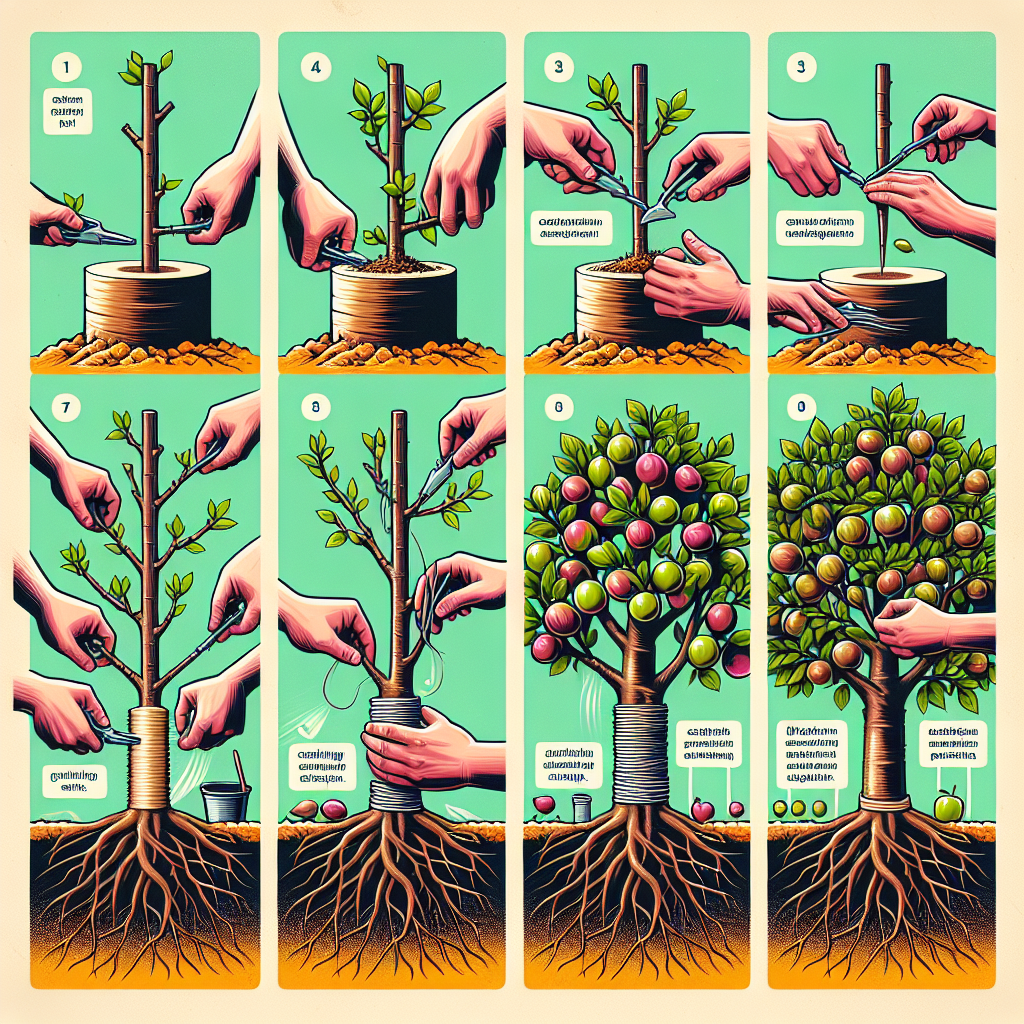Grafting Techniques for Fruit Trees
Updated July 12, 2024 at 8:20 pm

Understanding Grafting Techniques for Fruit Trees
Grafting is an essential horticultural technique you might be considering to maximize the productivity of your fruit trees. Think of it as a surgical connection between two plants, allowing them to grow as one. This can be especially useful if you’re looking to propagate your favorite variety or wanting to experiment with different types of fruits on a single tree. But, before we jump in, let’s outline some basics to keep in mind.
- Cutting Angle: A clean, precise angle is vital for successful grafting. The cut determines how well the graft union will hold.
- Scion and Rootstock Compatibility: Choose the scion (the part of the plant to be grafted) and the rootstock (the part that provides the root system) from species that are compatible with each other for a successful graft.
- Timing: Most grafting is done in late winter or early spring when the plants are dormant but just before they enter a rapid growth phase.
- Care and Maintenance: Post-graft, the tree needs special care, including proper watering, mulching, and sometimes staking to ensure the young graft isn’t disturbed.
Top Grafting Methods and Their Applications
There are several grafting methods available, and each has its own application depending on the condition of the plant material you’re working with and the outcome you’re aiming for. Let’s delve into a few.
Budding: Budding involves inserting a bud into the stock plant, rather than a shoot. It is often used for fruit tree varieties that do not graft well with other methods.
Whip Grafting: This technique is excellent for small diameter scions and rootstocks. Both are cut diagonally and joined together. It’s a simple, efficient method often used on young trees.
Cleft Grafting: When the stock is thicker than the scion, cleft grafting is the method of choice. A split is made in the stock, and the scion is inserted. This method is widely used in fruit trees to add new varieties to an existing tree.
Bridge Grafting: This method comes handy when the trunk of the tree is damaged. Scions are used to bridge the gap in the trunk, allowing nutrients to flow past the damaged area.
Necessary Tools and Materials for Grafting
For an effective grafting session, you’ll need the right tools and materials. These include a grafting knife, which is essential for making precise cuts, and grafting tape or wax to protect the grafter area until the union heals. Having a well-stocked toolkit can make all the difference in your success.
Grafting knives must be kept razor-sharp to ensure that the cuts are clean and do not harm the plant’s ability to heal. Brands like Victorinox and Opinel offer dedicated grafting knives whose blades are designed for this particular task.
Grafting tape is another must-have. It is flexible, allowing for the growth of the grafted area, and degrades over time, so it doesn’t need to be removed manually. Parafilm grafting tape is a popular choice among gardeners for its ease of use and effectiveness.
Find This and More on Amazon
Step-by-Step Process of Grafting
Here’s a general step-by-step process that you can follow for most types of grafting:
- Choose suitable scion wood and rootstock that are compatible and prepare them by making sure they are clean and free of any pests or diseases.
- Make matching cuts on both the scion and the rootstock. The goal is to maximize the cambial contact between the two pieces for successful grafting.
- Fit the scion into the rootstock securely, ensuring that the cuts match up well and that the cambium layers are in contact.
- Secure the graft with grafting tape or a similar material. Protect the graft from the elements and potential infections while it heals and begins to grow.
Remember, a little patience goes a long way. Grafts don’t always take the first time, but with practice, you can get more consistent results.
Aftercare: Ensuring the Success of Your Graft
Once a graft has been made, your job isn’t done. The care you provide in the subsequent weeks and months is crucial for the graft’s success. Pay attention to watering, mulching, and protection from pests. It’s a bit like caring for a little one, and your efforts can make all the difference between a thriving plant and a failed graft.
Additional support structures, like stakes or ties, might be needed for newly grafted trees to make sure they don’t break under the pressure of winds or the weight of new growth. Your patience and attention to detail during this time could be the deciding factor in the graft ‘taking’ or not.
Grafting Success Rates and Expectations
Grafting fruit trees can be both rewarding and challenging. Success rates can vary widely depending on the method used, the plants in question, and the environmental conditions. It is said that experienced grafters might see success rates of 90% or more, but don’t be discouraged if your first attempts aren’t perfect.
Grafting is as much an art as it is a science, so give yourself the grace to learn and improve. Some trees and grafts will take easily, while others might require a few attempts to perfect. Keep trying, and you’ll see your efforts bear fruit—literally!
Understanding Graft Compatibility and Stock Selection
One key aspect of grafting is understanding graft compatibility. This refers to how well the scion and rootstock will join and grow together. Compatibility is influenced by the genetic relationship between the two, with closely related species often having higher success rates.
To choose the right rootstock, consider the size you want your tree to attain, the soil conditions, and the resistance to pests and diseases it offers. Dwarfing rootstocks, for example, can greatly reduce the mature size of the tree, which is ideal for small gardens or easier harvesting.
Preparing Scions and Rootstocks
Preparing scions and rootstocks correctly is crucial. Scions should be collected from healthy, disease-free mother plants and stored in a cool, moist environment until you are ready to graft. The wood should be dormant, generally with last year’s growth for the best results.
Rootstocks should be alive and vigorous. They can either be seedlings or established trees, depending on the type of grafting you’re doing. When you are ready to graft, ensure that the tools you use are sterile to prevent the spread of disease.
Managing Grafting Challenges
One challenge you might face is ensuring that the scion does not dry out before the graft takes. This entails maintaining a high humidity environment, sometimes by using a plastic bag or specialized grafting wax to cover the graft, which also prevents the entry of pathogens.
Another challenge is matching the cambium layers of both scion and rootstock. The cambium is a layer of actively dividing cells, and its alignment is key to successful grafting. If you find aligning difficult due to different sizes of scion and rootstock, focus on aligning at least one side.
Maximizing Grafting Success
Maximizing the success of your grafts includes choosing the right time to graft, typically in late winter or early spring, maintaining sterile conditions, and selecting appropriate grafting methods for your fruit trees.
Additionally, some growers use root growth hormones or anti-transpirants to enhance graft success. Products like Dip ‘N Grow or Hormex can encourage faster healing and growth, but they should be used according to their instructions, keeping environmental regulations in mind.
Find This and More on Amazon
Grafting for Disease Resistance
Many fruit tree diseases are soil-borne and can be combated by grafting a susceptible variety onto a disease-resistant rootstock. This strategy is often used in apple orchards where certain rootstocks provide immunity or resistance to pests like woolly apple aphids.
Potentially, grafting onto a resistant rootstock can also give the newly grafted tree a more robust root system, better drought resistance, and the potential for a longer lifespan. It’s a tactic that blends the best traits of two different plant varieties.
Multi-Grafted Fruit Trees and Space Saving
If you’re limited on garden space, you might be interested in multi-grafted trees. These are trees that have several varieties of the same species grafted onto one stock. Not only is this a space-saving solution, but it also provides cross-pollination benefits, which can be absent in single-variety orchards.
Such trees are available for purchase but can also be created by an amateur grafter with a little practice. Multi-grafting allows you to enjoy a selection of fruit from a single tree, which is perfect for small-scale growers or those looking for variety without needing to plant numerous trees.
Ideas for Gardeners and Urban Orchards
You might be a home gardener looking to add fruit trees to your urban landscape, or possibly you’re considering starting a small orchard. Grafting can play a vital role in these endeavors, helping you maximize variety and productivity in limited spaces.
For urban orchards, high-density planting techniques paired with careful selection of rootstocks and grafting of preferred varieties can lead to a very productive space. You can achieve diverse harvests at different times of the year from a single small area of land.
Keeping a Gardening Journal
As you experiment with grafting, consider keeping a gardening journal. Note the types of grafts you’re trying, the time of year, weather conditions, and the success rates of each attempt. This documentation can become an invaluable resource for tracking your progress and repeating successful techniques.
A well-maintained journal can also help you remember specific varieties that performed particularly well in your climate or provided desirable fruit qualities, like taste or shelf life. Having this history will guide your future grafting decisions.
Purchase vs. DIY: What’s Best for Your Orchard?
While you can purchase grafted fruit trees from nurseries, there’s something rewarding about doing it yourself. DIY grafting allows you to select from a wider variety of scions and create trees that are truly unique to your garden.
Of course, purchasing grafted trees means you can bypass the learning curve and have a higher assurance of the tree’s initial survival. If you’re just starting out, consider buying a grafted tree to learn from and practice your own grafting techniques on lesser stakes.
Conclusion and Content area 3 of 3
Before winding down this discussion on grafting techniques for fruit trees, let’s remember that patience and persistence are your key allies in mastering this skill. Whether you’re tackling it as a hobby or with the intention of more serious production, each successful graft is a step towards a more bountiful and diverse orchard.
May your efforts in grafting lead to an orchard brimming with healthy, productive fruit trees. Embrace the journey of learning, reach out to gardening communities for support, and know that each cut, each splice, and each wrapped union is a link in the chain of horticultural knowledge. Here’s to the fruits of your labor being as sweet as the journey itself!
Community Support and Resources
Tapping into gardening communities, both local and online, can provide you with valuable insights and support in your grafting journey. Don’t hesitate to reach out to fellow gardeners or join forums and social media groups focused on fruit tree cultivation and grafting.
Attending workshops or local extension office presentations is another way to gain hands-on experience and knowledge. Experienced grafters are often eager to share their techniques and can provide tips that are specific to your microclimate and local soil conditions.
Grafting as a Tradition and Innovation
While grafting is a time-honored technique, innovation continues, and newer methods and materials are being developed. This blend of tradition and new technology is vital for advancing the practice of grafting and optimizing results.
New inventions in grafting tools and materials can make the process more efficient and increase success rates. An example would be the use of automatic grafting machines in commercial operations, which can produce consistent grafts at high volumes.
The Aesthetic Value of Grafted Fruit Trees
Grafted fruit trees do not only serve a productive purpose; they can also be aesthetically pleasing. Trees with multiple fruit types can create a stunning visual display in your garden, especially when the different varieties bloom or bear fruit at alternating times.
The beauty of these trees can enhance any garden’s landscape design, adding both variety and interest. It can become a centerpiece of conversation and pride in your home garden, all while providing delicious fruits for your table.
Environmental Impact and Sustainability
Adopting grafting techniques can also contribute to environmental sustainability. By selecting disease-resistant rootstocks, you can minimize the use of chemical sprays and interventions, reducing your orchard’s environmental footprint.
Grafted trees often mature and bear fruit faster than those grown from seeds, which can contribute to a quicker return on investment and less resource waste over time. This sustainability aspect may appeal to eco-conscious gardeners and small-scale farmers.
Final Thoughts and Encouragement
Whether you’re looking to cultivate a single grafted fruit tree in your backyard or manage a diverse orchard, grafting presents an opportunity for creativity and connection with nature. The patience and skill required are well worth the delectable rewards.
As with any gardening practice, every attempt at grafting teaches you something new. Celebrate both your successes and your learning experiences. With each graft, you’ll grow not just trees, but also your expertise and satisfaction in your horticultural endeavors. Happy grafting!
Shop more on Amazon

